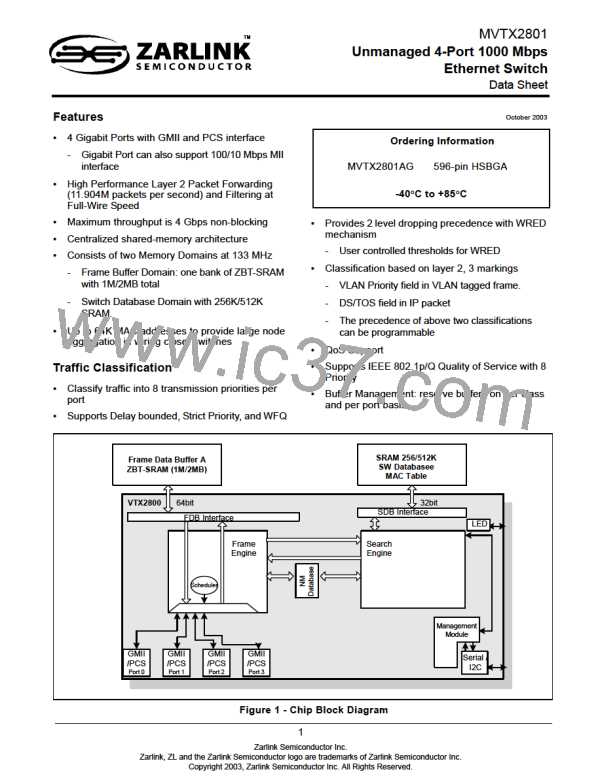MVTX2801
Data Sheet
4.2 Detailed Memory Information
Because the memory bus is 64 bits wide, frames are broken into 8-byte granules, written to and read from each
memory access. In the worst case, a 1-byte-long EOF granule gets written to memory Bank. This means that a
7-byte segment of memory bus is idle. The scenario results in a maximum 7 bytes of waste per frame, which is
always acceptable because the interfame gap is 20 bytes.
5.0 Search Engine
5.1 Search Engine Overview
The MVTX2801 search engine is optimized for high throughput searching, with enhanced features to support:
•
•
•
Up to 64K MAC addresses
4 groups of port trunking
Traffic classification into 8 transmission priorities, and 2 drop precedence levels
5.2 Basic Flow
Shortly after a frame enters the MVTX2801 and is written to the Frame Data Buffer (FDB), the frame engine
generates a Switch Request, which is sent to the search engine. The switch request consists of the first 64 bytes of
the frame, which contain all the necessary information for the search engine to perform its task. When the search
engine is done, it writes to the Switch Response Queue, and the frame engine uses the information provided in that
queue for scheduling and forwarding.
In performing its task, the search engine extracts and compresses the useful information from the 64-byte switch
request. Among the information extracted are the source and destination MAC addresses, the transmission and
discard priorities, whether the frame is unicast or multicast. Requests are sent to the external SRAM Switch
Database to locate the associated entries in the external MCT table.
When all the information has been collected from external SRAM, the search engine has to compare the MAC
address on the current entry with the MAC address for which it is searching. If it is not a match, the process is
repeated on the internal MCT Table. All MCT entries other than the first of each linked list are maintained internal to
the chip. If the desired MAC address is still not found, then the result is either learning (source MAC address
unknown) or flooding (destination MAC address unknown).
If the destination MAC address belongs to a port trunk, then the trunk number is retrieved instead of the port number.
But on which port of the trunk will the frame be transmitted? This is easily computed using a hash of the source and
destination MAC addresses.
When all the information is compiled, the switch response is generated, as stated earlier.
5.3 Search, Learning, and Aging
5.3.1 MAC Search
The search block performs source MAC address and destination MAC address searching. As we indicated earlier,
if a match is not found, then the next entry in the linked list must be examined, and so on until a match is found or
the end of the list is reached.
In port based VLAN mode, a bitmap is used to determine whether the frame should be forwarded to the outgoing
port. The bitmap is not dynamic. Ports cannot enter and exit groups dynamically.
The MAC search block is also responsible for updating the source MAC address timestamp, used for aging.
15
Zarlink Semiconductor Inc.

 ZARLINK [ ZARLINK SEMICONDUCTOR INC ]
ZARLINK [ ZARLINK SEMICONDUCTOR INC ]